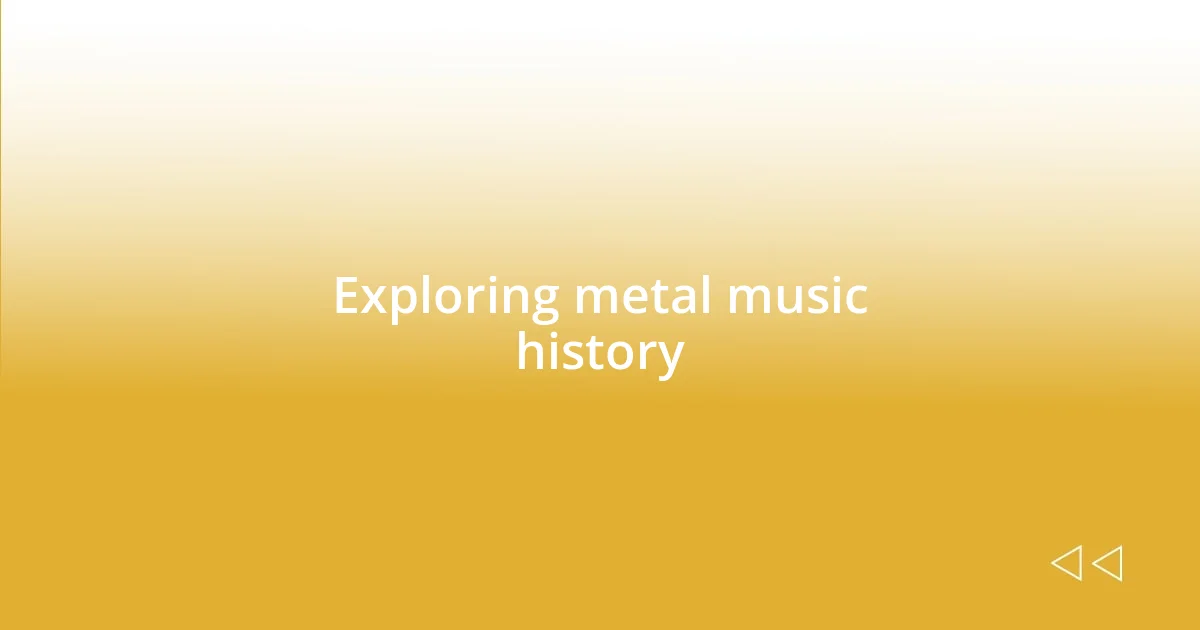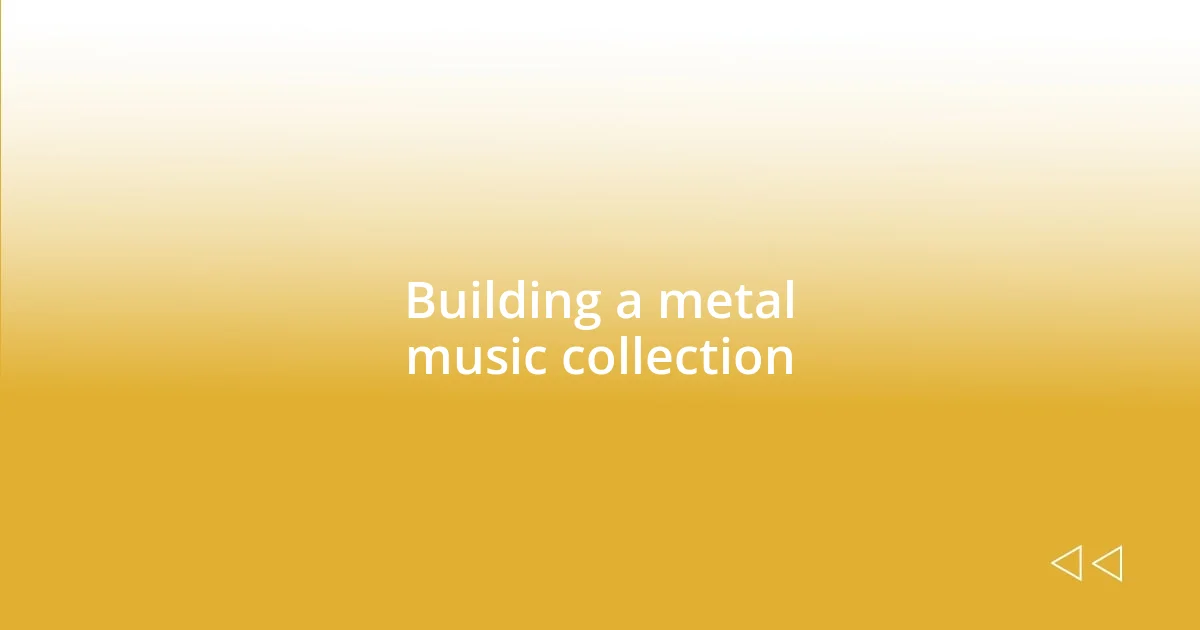Key takeaways:
- Metal music encompasses various subgenres, each evoking unique emotions and experiences, from thrash and doom to progressive metal.
- Engaging with iconic bands like Iron Maiden and Black Label Society enhances the appreciation of metal’s rich heritage and emotional depth.
- Building a metal music collection and connecting with the community fosters meaningful relationships and personal growth, enriching the journey of musical exploration.

Understanding metal music genres
Metal music is a vibrant tapestry woven from various subgenres, each offering its unique sound and emotional resonance. When I first stumbled upon thrash metal, the raw energy and speed captivated me. I remember the rush I felt listening to bands like Metallica and Slayer, feeling as if the music lit a fire inside me. Isn’t it fascinating how a song can stir such visceral emotions?
As I explored further, I encountered doom metal, characterized by its slow, heavy riffs and haunting themes. The first time I listened to Black Sabbath, it was an entirely different emotional experience. I discovered this intense sense of melancholy—almost like the music was narrating a story of struggle and despair. Can you remember a time when a song made you reflect deeply or brought tears to your eyes? For me, that was Black Sabbath’s “N.I.B.”
Then there’s the realm of progressive metal, with its complex structures and lyrical depth. I’ll never forget my first encounter with Dream Theater; it felt like I was invited to a musical journey that challenged my understanding of songwriting. The intricate guitar solos and elaborate compositions made me ponder—how can a single genre be so diverse and intellectually demanding? These genres showcased metal’s incredible range, revealing not just a style of music, but a vast universe of emotions and stories.

Discovering iconic metal bands
As I delved deeper into the metal scene, iconic bands like Iron Maiden and Judas Priest came to my attention. Their powerful anthems and amazing stage presence sparked something in me that was hard to ignore. I can vividly recall my first experience with Iron Maiden’s “The Trooper”—it felt like a battle cry that transported me to a live concert in my imagination, something that still gives me goosebumps to this day.
Then there was Black Label Society, whose heavy riffs and compelling lyrics resonated with me during tough times. Listening to “In This River” felt like a personal conversation, each note echoing my own struggles and triumphs. Have you ever experienced a song that felt like it was written just for you? That’s what it was like for me; Zakk Wylde’s raw emotion struck a chord that stayed with me long after the music stopped.
Finally, I couldn’t overlook the influence of original heavy metal pioneers like Deep Purple and Led Zeppelin. Their creative innovations laid the groundwork for countless metal subgenres. I remember the first time I heard “Smoke on the Water” blaring from my speakers—it was more than just a song; it was a declaration of the power of rock music. These bands taught me that metal is not just a genre, but a rich heritage that continues to inspire countless fans and musicians alike.
| Band | Notable Song |
|---|---|
| Iron Maiden | The Trooper |
| Black Label Society | In This River |
| Deep Purple | Smoke on the Water |

Exploring metal music history
Exploring the history of metal music is like peeling back layers of a rich and complex onion. It all began in the late 1960s, where rock and blues effortlessly intertwined, giving birth to the earliest influences like The Beatles and The Rolling Stones. I still remember the moment I understood that metal was more than just heavy guitars; it was a powerful expression of rebellion and individuality. The sheer power of Black Sabbath’s debut album in 1970 completely reshaped the musical landscape, marking the moment we stepped into the realm of true heavy metal.
As the years progressed, metal began to diversify into various subgenres, each reflecting unique cultural contexts and sounds. Here are some key milestones in metal history:
- 1970s: The birth of heavy metal with bands like Black Sabbath and Led Zeppelin, pioneering a darker, heavier sound.
- 1980s: The emergence of thrash, death, and glam metal, led by bands such as Metallica, Slayer, and Mötley Crüe, introducing fast tempos and theatricality.
- 1990s: The rise of alternative metal and nu-metal, exemplified by acts like Korn and Rage Against the Machine, bridging metal themes with other genres.
- 2000s and beyond: The evolution continued with genres like metalcore and progressive metal, showcasing technical musicianship and depth in lyrical themes.
Each era contributed to a vibrant tapestry that reflects both the struggles and triumphs of its time, resonating with fans on a deeply personal level. It’s incredible to think about how a single genre can evolve yet maintain its core essence of expressing raw emotion.

Attending live metal concerts
Attending live metal concerts has been a transformative experience for me. The electrifying atmosphere, combined with the pounding energy of the crowd, creates a sense of belonging that is hard to replicate. I can remember my first concert vividly; as soon as the lights dimmed, I felt my heart race in anticipation. The moment the band took the stage, I realized that seeing my favorite artists live was like stepping into a different world where everything felt alive and intense.
Each concert I’ve attended has been a unique journey. I recall a particularly unforgettable night with a local metal band, where their raw passion and dedication transformed what could have been a simple venue into a sacred space. The way the lead singer connected with the audience, inviting us to sing along, made me feel like I was part of something larger than myself. Have you ever felt the surge of collective exhilaration when everyone around you is united by the same love for music? In that moment, I discovered the true power of live performances—they transcend individual experiences and fuse disparate lives into a single harmony.
It’s also fascinating how each concert offers a chance to forge lasting memories. At a recent festival, I stood shoulder-to-shoulder with fellow fans, everyone thrashing about to the infectious rhythm of the band. It wasn’t just the music that captivated me, but the shared emotions and camaraderie that unfolded in those moments. After all, isn’t live metal about more than just the sound? It’s a celebration of rebellion, unity, and the unapologetic spirit of the genre. I left the show not just with new favorite tracks but with new friends and stories that connected us in unforgettable ways.

Building a metal music collection
Building a metal music collection is a deeply personal journey, one that reflects your own tastes and experiences. For me, my collection began with a few essential albums. I remember purchasing Metallica’s “Master of Puppets” on vinyl; the artwork instantly drew me in. Holding that record in my hands felt like I was grasping a piece of history. It was my first taste of the power and complexity that metal could offer, and I still cherish the sound of the needle hitting the grooves.
As I expanded my collection, I took time to explore various subgenres, which opened up a world of sounds and themes. From the melodic intricacies of power metal to the raw intensity of black metal, I learned to appreciate the distinct flavors each style brought to the table. One day, I’d stumble upon an obscure death metal band while mindlessly browsing an online music forum. I took a leap of faith and bought an album, which later became a staple in my playlist. Had I not taken that chance, I’d have missed out on what quickly became one of my favorite genres. Isn’t it amazing how one decision can lead you down such exciting paths?
I also found it rewarding to connect with fellow metalheads on this quest. Sharing recommendations has not only helped me uncover hidden gems but has also led to some unforgettable discussions and friendships. I remember a late-night conversation with a friend about the lyrical prowess of Iron Maiden; the way we dissected the stories behind their songs truly deepened my appreciation. It made me realize that building a metal collection isn’t just about the music itself—it’s also about the connections, memories, and emotions tied to each album. By digging into the layers of metal, we create a personal narrative that resonates throughout our lives.

Connecting with the metal community
Connecting with the metal community has been one of the most fulfilling aspects of my journey. I recall a time when I ventured into an online forum filled with passionate fans. The discussions were electrifying, and I was struck by how quickly I found my voice among strangers who felt like kindred spirits. Isn’t it incredible how a shared love for music can bridge gaps and foster a sense of belonging, even among people you’ve never met?
Beyond the digital spaces, I’ve cherished informal meet-ups with fellow metalheads. At a local pub, I once struck up a conversation with a guitarist who played in a band I adored. Sharing stories about our favorite tracks and debating who the greatest metal vocalist is illuminated how diverse our perspectives could be, yet we were all united by that same burning passion for metal. It’s these spontaneous interactions that remind me that connecting with the metal community is about more than just the music—it’s about building relationships that amplify the experience.
One of the most profound moments for me happened during a group listening session at a friend’s house. As we each shared the albums that shaped us, I was moved to see how metal served as a soundtrack to our lives. The emotions that surfaced while reminiscing over pivotal tracks highlighted the depth of our connections. Have you ever had that moment when you realized how intertwined your experiences are with a genre? For me, it was a powerful reminder that the metal community is not just a collection of fans; it’s a family forged through shared experiences and mutual respect.

Creating your own metal music
Creating your own metal music is an exhilarating process that begins with finding your authentic voice. I remember sitting in my room for hours, guitar in hand, trying to mimic the riffs that electrified me as a kid. Each note I played felt like a progression towards an identity I was carving out for myself, one that resonated with the raw emotions I often felt. What better way to express the chaos and beauty of life than through the thunderous sounds of metal?
As I dove deeper into songwriting, I discovered that storytelling plays a crucial role in my music. I would often jot down ideas based on experiences that stirred strong feelings within me. One time, I penned a piece that mirrored a particularly tough breakup. The visceral metaphors and heavy breakdowns helped me channel my pain, transforming it into something powerful I could share. Have you ever experienced that cathartic moment of turning hurt into art? That’s the magic of creating metal music.
Collaborating with other musicians encouraged me to step outside my comfort zone. I recall a jam session with friends where we fused our different influences—thrash, doom, and even a touch of progressive elements. The result was mind-blowing! It reminded me that metal is a vast landscape where innovation thrives, and each collaborative experience added a new layer to my understanding of the genre. This process of mutual creation can be incredibly fulfilling, forging bonds that fuel both personal growth and the music itself. So, are you ready to embrace the chaos and start shaping your unique contribution to the metal scene?















